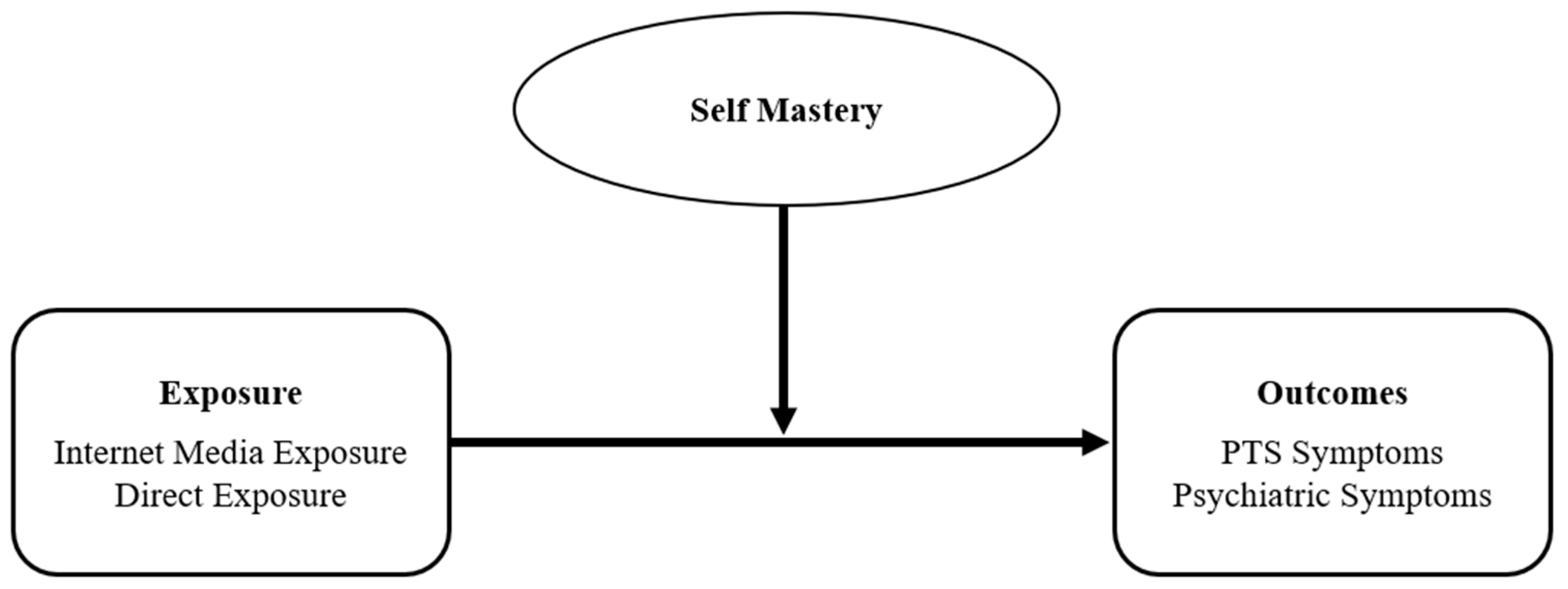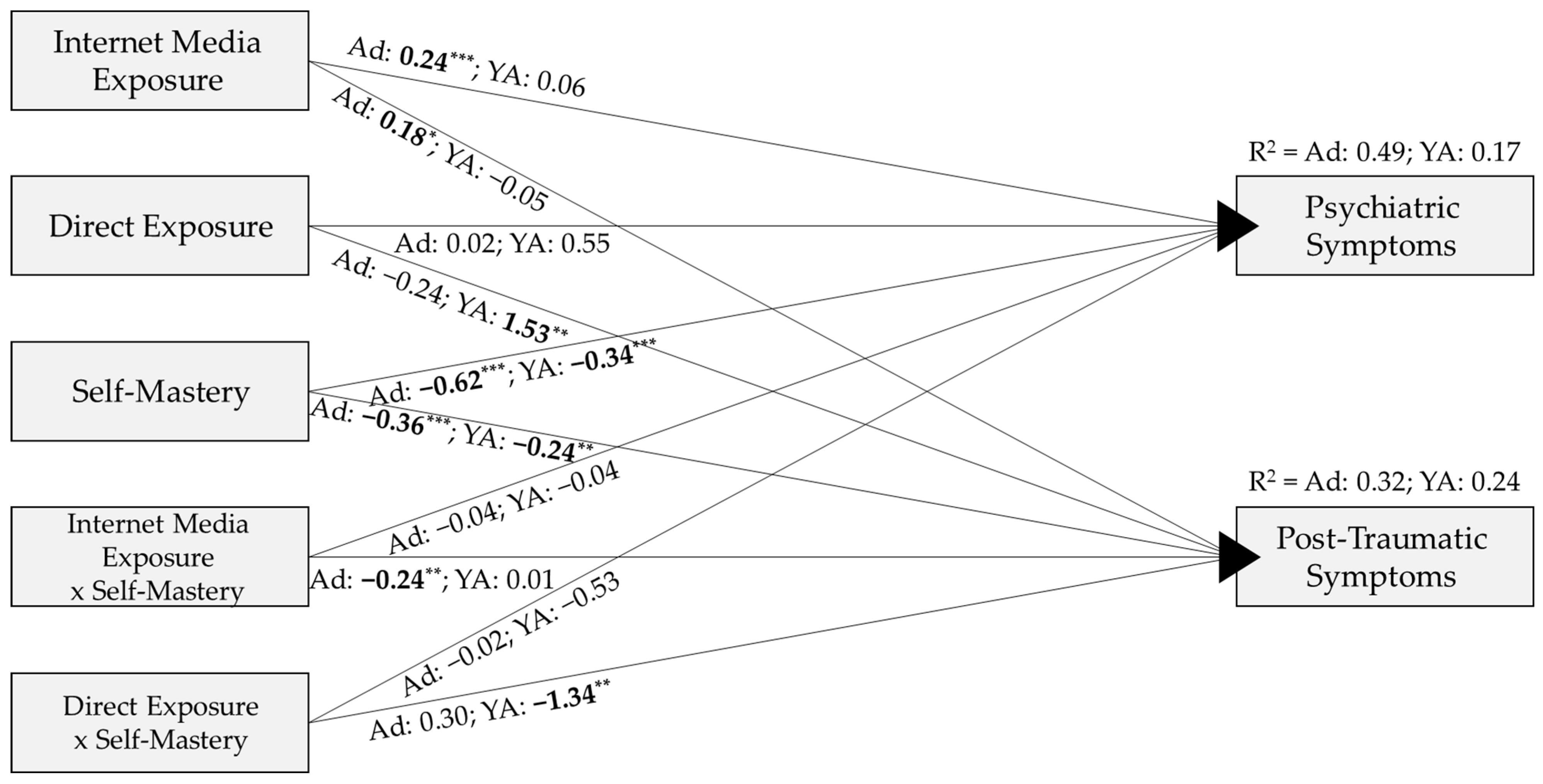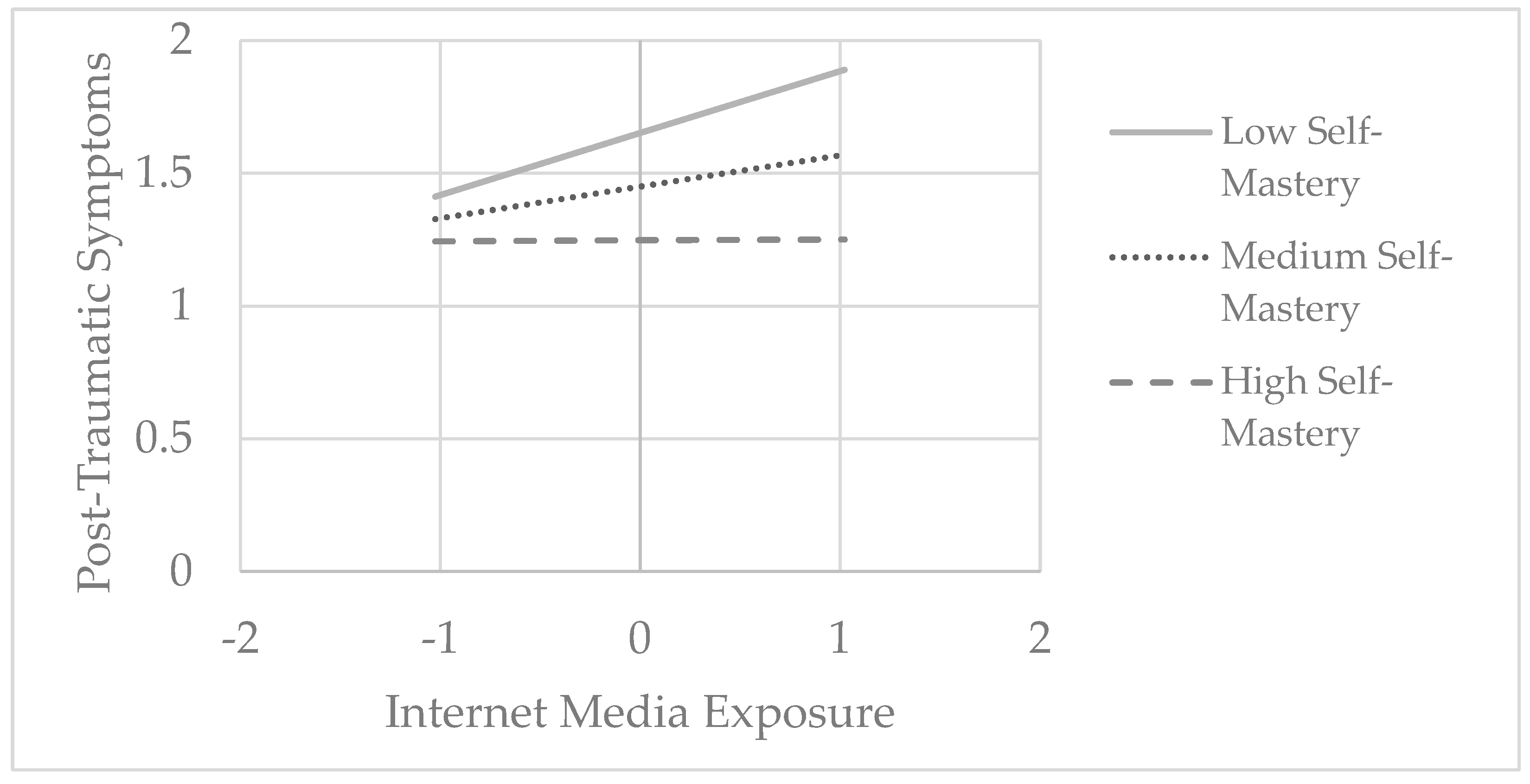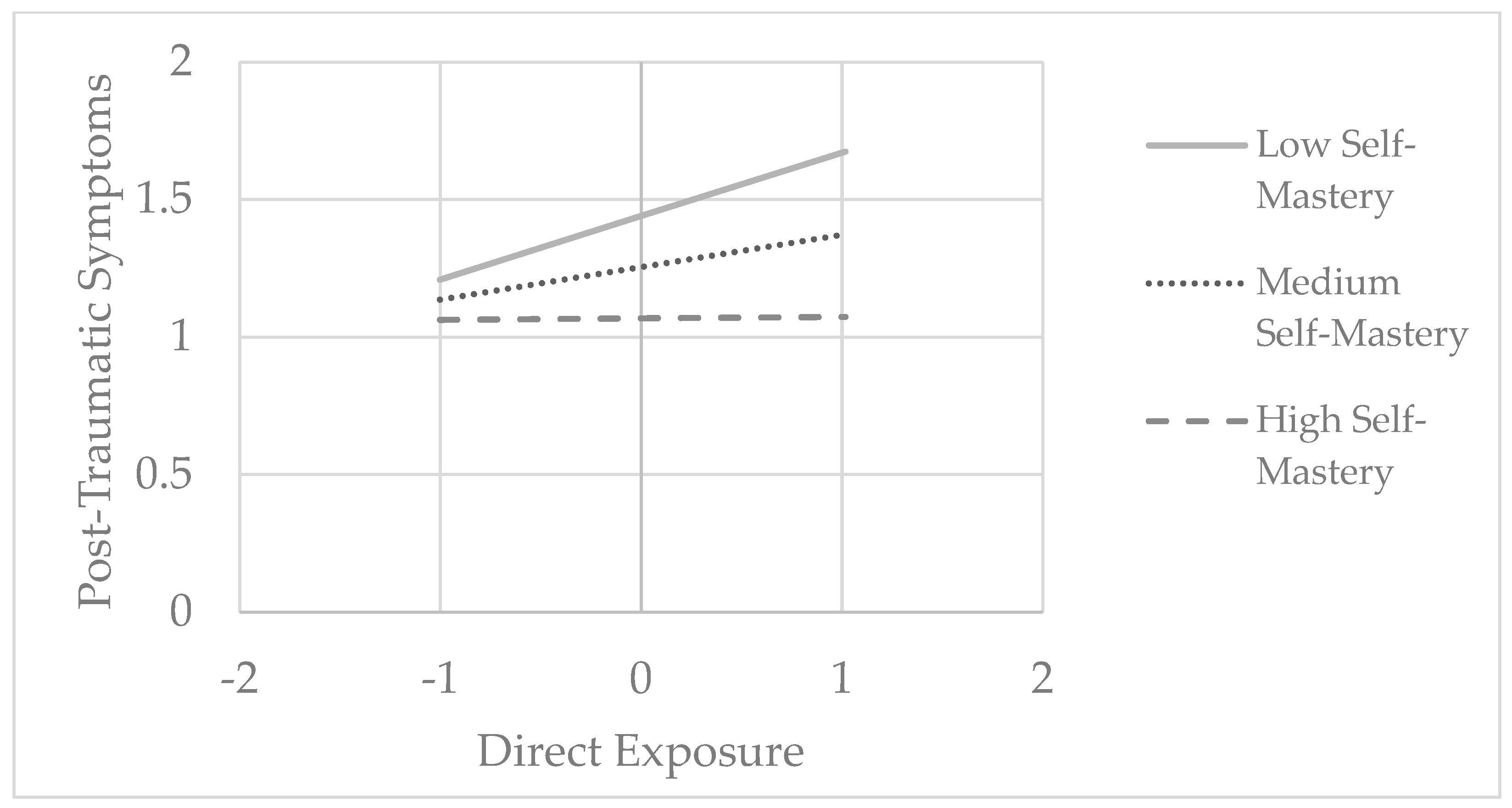Adolescent Vulnerability to Internet Media Exposure: The Role of Self-Mastery in Mitigating Post-Traumatic Symptoms
Abstract
1. Introduction
1.1. The Rise of the Internet and Social Media
1.2. Internet Media Exposure to Armed Conflict Events
1.3. Internet Media Exposure to Armed Conflict Events Among Adolescents
1.4. Internet Media Exposure to Armed Conflict Events Among Young Adults
1.5. The Developmental Perspective on Brain Changes from Adolescence to Adulthood
1.6. Adolescent Coping with Trauma
Self-Mastery as a Resilience Factor
1.7. The Present Study
1.8. Hypotheses
- A.
- Direct Relationship between Internet Media Exposure and Symptoms: Hypothesis 1 posited a positive relationship between the extent of internet media exposure to armed conflict events and levels of post-traumatic symptoms and psychiatric symptomatology for each age group.
- B.
- Direct Relationship between Direct Exposure and Symptoms: Hypothesis 2 posited a positive relationship between the severity of direct exposure to armed conflict events and levels of post-traumatic symptoms and psychiatric symptomatology for each age group.
- C.
- Moderation Effect of Self-Mastery: Hypothesis 3 posited that self-mastery will moderate the relationship between exposure to armed conflict events, both direct and via the internet, and post-traumatic symptoms and psychiatric symptomatology for each age group.
- D.
- Exploratory Question on Age Group Differences: An exploratory analysis aimed to investigate potential differences between adolescents and young adults in the effects of direct and internet-based exposure to armed conflict events, including the moderating role of self-mastery for each age group.
2. Materials and Methods
2.1. Participants
2.2. Instruments
2.2.1. Direct Exposure to Armed Conflict Events
2.2.2. Internet Media Exposure to Armed Conflict Events
2.2.3. Self-Mastery
2.2.4. Psychiatric Symptoms
2.2.5. Post-Traumatic Symptoms
2.3. Procedure
2.4. Data Analysis
3. Results
3.1. Preliminary Analysis
3.2. Mediation Moderation Analysis
4. Discussion
Study Limitations
5. Conclusions
Author Contributions
Funding
Institutional Review Board Statement
Informed Consent Statement
Data Availability Statement
Conflicts of Interest
References
- Buneviciene, I.; Bunevicius, A. Prevalence of internet addiction in healthcare professionals: Systematic review and meta-analysis. Int. J. Soc. Psychiatry 2021, 67, 483–491. [Google Scholar] [CrossRef] [PubMed]
- Garfin, D.R. Technology as a coping tool during the coronavirus disease 2019 (COVID-19) pandemic: Implications and recommendations. Stress. Health 2020, 36, 555–559. [Google Scholar] [CrossRef]
- Jones, N.M.; Thompson, R.R.; Schetter, C.D.; Silver, R.C. Distress and rumor exposure on social media during a campus lockdown. Proc. Natl. Acad. Sci. USA 2017, 114, 11663–11668. [Google Scholar] [CrossRef] [PubMed]
- Slone, M.; Shoshani, A. Prevention rather than cure ? Primary or secondary intervention for dealing with media exposure to terrorism. J. Couns. Dev. 2010, 88, 440–448. [Google Scholar] [CrossRef]
- Hjetland, G.J.; Schønning, V.; Hella, R.T.; Veseth, M.; Skogen, J.C. How do Norwegian adolescents experience the role of social media in relation to mental health and well-being: A qualitative study. BMC Psychol. 2021, 9, 78. [Google Scholar] [CrossRef] [PubMed]
- Kuss, D.J.; Griffiths, M.D. Online social networking and addiction-A review of the psychological literature. Int. J. Environ. Res. Public Health 2011, 8, 3528–3552. [Google Scholar] [CrossRef]
- Huang, R.L.; Lu, Z.; Liu, J.J.; You, Y.M.; Pan, Z.Q.; Wei, Z.; He, Q.; Wang, Z. Features and predictors of problematic internet use in Chinese college students. Behav. Inf. Technol. 2009, 28, 485–490. [Google Scholar] [CrossRef]
- Fu, K.W.; Chan, W.S.C.; Wong, P.W.C.; Yip, P.S.F. Internet addiction: Prevalence, discriminant validity and correlates among adolescents in Hong Kong. Br. J. Psychiatry 2010, 196, 486–492. [Google Scholar] [CrossRef]
- Gottfried, J.; Shearer, E. Americans’ Online News Use Is Closing in on TV News Use. Pew Res. Cent. 2017, 7, 1–3. Available online: https://web.archive.org/web/20170911183614/http://www.pewresearch.%0Aorg/fact-tank/2017/09/07/americans-online-news-use-vs-tv-news-use (accessed on 3 January 2025).
- Thompson, R.R.; Holman, E.A.; Silver, R.C. Worst life events and media exposure to terrorism in a nationally representative U.S. sample. J. Trauma. Stress. 2020, 33, 984–993. [Google Scholar] [CrossRef]
- Chrisman, A.K.; Dougherty, J.G. Mass trauma: Disasters, terrorism, and war. Child. Adolesc. Psychiatr. Clin. N. Am. 2014, 23, 257–279. [Google Scholar] [CrossRef] [PubMed]
- Rubaltelli, E.; Scrimin, S.; Moscardino, U.; Priolo, G.; Buodo, G. Media exposure to terrorism and people’s risk perception: The role of environmental sensitivity and psychophysiological response to stress. Br. J. Psychol. 2018, 109, 656–673. [Google Scholar] [CrossRef] [PubMed]
- Salguero, J.M.; Fernández-Berrocal, P.; Iruarrizaga, I.; Cano-Vindel, A.; Galea, S. Major depressive disorder following terrorist attacks: A systematic review of prevalence, course and correlates. BMC Psychiatry 2011, 11, 96. [Google Scholar] [CrossRef] [PubMed]
- Bilger, A. ISIS Annual Reports Reveal a Metrics-Driven Military Command, Institute for the Study of War, 22 May 2014. Available online: https://www.understandingwar.org/sites/default/files/ISWBackgrounder_ISIS_Annual_Reports_0.pdf (accessed on 5 January 2025).
- Klemm, C.; Das, E.; Hartmann, T. Swine flu and hype: A systematic review of media dramatization of the H1N1 influenza pandemic. J. Risk Res. 2016, 19, 1–20. [Google Scholar] [CrossRef]
- Yu, N.; Frohlich, D.O.; Fougner, J.; Ren, L. Communicating a health epidemic: A risk assessment of the Swine Flu coverage in US newspapers. Int. Public Health J. 2011, 3, 63. [Google Scholar]
- Grabe, M.E.; Kamhawi, R.; Yegiyan, N. Informing citizens: How people with different levels of education process television, newspaper, and web news. J. Broadcast. Electron. Media 2009, 53, 90–111. [Google Scholar] [CrossRef]
- Goodall, C.; Sabo, J.; Cline, R.; Egbert, N. Threat, efficacy, and uncertainty in the first 5 months of national print and electronic news coverage of the H1N1 virus. J. Health Commun. 2012, 17, 338–355. [Google Scholar] [CrossRef]
- Shoshani, A.; Slone, M. Through the looking glass: The role of ethnicity and affiliation in responses to terrorism in the media. Front. Psychol. 2016, 7, 01911. [Google Scholar] [CrossRef][Green Version]
- Pereda, N. Systematic review of the psychological consequences of terrorism among child victims. Int. Rev. Vict. 2013, 19, 181–199. [Google Scholar] [CrossRef]
- Aly, A.; Macdonald, S.; Jarvis, L.; Chen, T.M. Introduction to the special issue: Terrorist online propaganda and radicalization. Stud. Confl. Terror. 2017, 40, 1–9. [Google Scholar] [CrossRef]
- Rudner, M. “Electronic jihad”: The internet as Al Qaeda’s catalyst for global terror. Stud. Confl. Terror. 2017, 40, 10–23. [Google Scholar] [CrossRef]
- Dar, A.A.; Deb, S. Prevalence of trauma among young adults exposed to stressful events of armed conflicts in South Asia: Experiences from Kashmir. Psychol. Trauma Theory Res. Pract. Policy 2021, 14, 633–641. [Google Scholar] [CrossRef] [PubMed]
- Becker-blease, K.A.; Turner, H.A.; Finkelhor, D. Disasters, Victimization, and Children’ s Mental Health. Child Dev. 2010, 81, 1040–1052. [Google Scholar] [CrossRef]
- Slone, M.; Lavi, I.; Ozer, E.J.; Pollak, A. The Israeli-Palestinian conflict: Meta-analysis of exposure and outcome relations for children of the region. Child. Youth Serv. Rev. 2017, 74, 50–61. [Google Scholar] [CrossRef]
- Mijanovich, T.; Weitzman, B.C. Disaster in context: The effects of 9/11 on youth distant from the attacks. Community Ment. Health J. 2010, 46, 601–611. [Google Scholar] [CrossRef] [PubMed]
- Enav, Y.; Shiffman, N.; Lurie, I.; Mayer, Y. War, media, and emotion: Associations between posttraumatic stress symptoms, anxiety, and emotion regulation. Psychol. Trauma Theory Res. Pract. Policy 2024. advance online publication. [Google Scholar] [CrossRef]
- Bhat, R.M.; Rangaiah, B. Exposure to armed conflict and prevalence of posttraumatic stress symptoms among young adults in Kashmir, India. J. Aggress. Maltreatment Trauma 2015, 24, 740–752. [Google Scholar] [CrossRef]
- Holman, E.A.; Garfin, D.R.; Silver, R.C. Media’s role in broadcasting acute stress following the Boston Marathon bombings. Proc. Natl. Acad. Sci. USA 2014, 111, 93–98. [Google Scholar] [CrossRef]
- Peer, A.; Slone, M. Media exposure to armed conflict: Dispositional optimism and self-mastery moderate distress and post-traumatic symptoms among adolescents. Int. J. Environ. Res. Public Health 2022, 19, 11216. [Google Scholar] [CrossRef]
- Wallace, L.N. Exposure to Terrorism-related news: Associations with beliefs about terrorism and self-protective action. Commun. Stud. 2021, 72, 420–436. [Google Scholar] [CrossRef]
- Pew Research Center. Teens, Social Media, and Technology. 2023. Available online: https://www.pewresearch.org/internet/2023/12/11/teens-social-media-and-technology-2023/ (accessed on 30 December 2024).
- Pew Research Center. Mobile Fact Sheet. 2024. Available online: https://www.pewresearch.org/internet/fact-sheet/mobile (accessed on 3 January 2025).
- Seabrook, E.M.; Kern, M.L.; Rickard, N.S. Social networking sites, depression, and anxiety: A systematic review. JMIR Ment. Health 2016, 3, e50. [Google Scholar] [CrossRef] [PubMed]
- Uhls, Y.T.; Ellison, N.B.; Subrahmanyam, K. Benefits and costs of social media in adolescence. Pediatrics 2017, 140, S67–S70. [Google Scholar] [CrossRef] [PubMed]
- Spies Shapiro, L.A.; Margolin, G. Growing up wired: Social networking sites and adolescent psychosocial development. Clin. Child. Fam. Psychol. Rev. 2014, 17, 1–18. [Google Scholar] [CrossRef]
- Underwood, M.K.; Ehrenreich, S.E. The power and the pain of adolescents’ digital communication: Cyber victimization and the perils of lurking. Am. Psychol. 2017, 72, 144–158. [Google Scholar] [CrossRef] [PubMed]
- Vannucci, A.; McCauley Ohannessian, C. Social media use subgroups differentially predict psychosocial well-being during early adolescence. J. Youth Adolesc. 2019, 48, 1469–1493. [Google Scholar] [CrossRef]
- Keles, B.; McCrae, N.; Grealish, A. A systematic review: The influence of social media on depression, anxiety and psychological distress in adolescents. Int. J. Adolesc. Youth 2020, 25, 79–93. [Google Scholar] [CrossRef]
- Crone, E.A.; Van Duijvenvoorde, A.C.K.; Peper, J.S. Annual research review: Neural contributions to risk-taking in adolescence—Developmental changes and individual differences. J. Child. Psychol. Psychiatry Allied Discip. 2016, 57, 353–368. [Google Scholar] [CrossRef]
- Braams, B.R.; van Duijvenvoorde, A.C.K.; Peper, J.S.; Crone, E.A. Longitudinal changes in adolescent risk-taking: A comprehensive study of neural responses to rewards, pubertal development, and risk-taking behavior. J. Neurosci. 2015, 35, 7226–7238. [Google Scholar] [CrossRef]
- Ravindran, N.; Hu, Y.; McElwain, N.L.; Telzer, E.H. Dynamics of mother-adolescent and father-Adolescent autonomy and control during a conflict discussion task. J. Fam. Psychol. 2020, 34, 312–321. [Google Scholar] [CrossRef]
- Liu, L.; Wang, N.; Tian, L. The parent-adolescent relationship and risk-taking behaviors among Chinese adolescents: The moderating role of self-control. Front. Psychol. 2019, 10, 00542. [Google Scholar] [CrossRef]
- Dvir Gvirsman, S.; Huesmann, L.R.; Dubow, E.F.; Landau, S.F.; Shikaki, K.; Boxer, P. The effects of mediated exposure to ethnic-political violence on Middle East youth’s subsequent post-traumatic stress symptoms and aggressive behavior. Communic. Res. 2014, 41, 961–990. [Google Scholar] [CrossRef] [PubMed]
- Gvirsman, S.D.; Huesmann, L.R.; Dubow, E.F.; Landau, S.F.; Boxer, P.; Shikaki, K. The longitudinal effects of chronic mediated exposure to political violence on ideological beliefs about political conflicts among youths. Polit. Commun. 2016, 33, 98–117. [Google Scholar] [CrossRef]
- Khurana, A.; Bleakley, A.; Jordan, A.B.; Romer, D. The protective effects of parental monitoring and internet restriction on adolescents ’ risk of online harassment. J. Youth Adol. 2015, 44, 1039–1047. [Google Scholar] [CrossRef]
- Barry, C.T.; Kim, H. Parental monitoring of adolescent social media use: Relations with adolescent mental health and self-perception. Curr. Psychol. 2024, 43, 2473–2485. [Google Scholar] [CrossRef]
- Padilla-Walker, L.M.; Coyne, S.M.; Collier, K.M. Longitudinal relations between parental media monitoring and adolescent aggression, prosocial behavior, and externalizing problems. J. Adolesc. 2016, 46, 86–97. [Google Scholar] [CrossRef]
- Padilla-Walker, L.M.; Stockdale, L.A.; McLean, R.D. Associations between parental media monitoring, media use, and internalizing symptoms during adolescence. Psychol. Pop. Media 2020, 9, 481–492. [Google Scholar] [CrossRef]
- Arnett, J.J. The Oxford Handbook of Emerging Adulthood; Oxford University Press: Oxford, UK, 2015. [Google Scholar] [CrossRef]
- Arnett, J.J. Identity development from adolescence to emerging adulthood: What we know and (especially) don’t know. In The Oxford Handbook of Identity Development; Oxford Academic: Oxford, UK, 2015; pp. 53–64. [Google Scholar] [CrossRef]
- Wood, D.; Crapnell, T.; Lau, L.; Bennett, A.; Lotstein, D.; Ferris, M.K.A. Emerging Adulthood as a Critical Stage in the Life Course. In Handbook of Life Course Health Development; Halfon, N., Forrest, C.B., Lerner, R.M.F.E., Eds.; Springer US: New York, NY, USA, 2018; p. 31314293. [Google Scholar] [CrossRef]
- Liu, J.; Zhang, Y.; Qiu, J.; Wei, D. Linking negative affect, personality and social conditions to structural brain development during the transition from late adolescent to young adulthood. J. Affect. Disord. 2023, 325, 14–21. [Google Scholar] [CrossRef] [PubMed]
- Modabbernia, A.; Janiri, D.; Doucet, G.; Reichenberg, A.; Frangou, S. Brain Phenotypes Capture Broad Aspects of Behavior and Environment in Youth: Findings From the Adolescent Brain and Cognitive Development (ABCD) Study. Biol. Psychiatry 2020, 87, S147. [Google Scholar] [CrossRef]
- Taber-Thomas, B.; Perez-Edgar, K. Emerging adulthood brain development. Oxf. Handb. Online 2014, 8, 1–19. [Google Scholar] [CrossRef]
- Desatnik, A.; Bird, A.; Shmueli, A.; Venger, I.; Fonagy, P. The mindful trajectory: Developmental changes in mentalizing throughout adolescence and young adulthood. PLoS ONE 2023, 18, 1–20. [Google Scholar] [CrossRef]
- Cristello, J.V.; Strowger, M.; Moreno, M.A.; Trucco, E.M. Navigating the modern landscape of social media: Ethical considerations for research with adolescents and young adults. Transl. Issues Psychol. Sci. 2024, 10, 123–134. [Google Scholar] [CrossRef] [PubMed]
- Silver, R.C.; Holman, E.A.; Andersen, J.P.; Poulin, M.; McIntosh, D.N.; Gil-Rivas, V. Mental- and physical-health effects of acute exposure to media images of the September 11, 2001, attacks and the Iraq War. Psychol. Sci. 2013, 24, 1623–1634. [Google Scholar] [CrossRef] [PubMed]
- Monfort, E.; Afzali, M.H. Traumatic stress symptoms after the November 13th 2015 Terrorist Attacks among Young Adults: The relation to media and emotion regulation. Compr. Psychiatry 2017, 75, 68–74. [Google Scholar] [CrossRef]
- Soffer-Dudek, N.; Shahar, G. Effect of exposure to terrorism on sleep-related experiences in Israeli young adults. Psychiatry 2010, 73, 264–276. [Google Scholar] [CrossRef] [PubMed]
- Mills, K.L.; Siegmund, K.D.; Tamnes, C.K.; Ferschmann, L.; Wierenga, L.M.; Bos, M.G.; Luna, B.; Li, C.; Herting, M.M. Inter-individual variability in structural brain development from late childhood to young adulthood. Neuroimage 2021, 242, 118450. [Google Scholar] [CrossRef]
- Sebastian, C.L.; Fontaine, N.M.G.; Bird, G.; Blakemore, S.-J.; De Brito, S.A.; McCrory, E.J.P.; Viding, E. Neural processing associated with cognitive and affective theory of mind in adolescents and adults. Soc. Cogn. Affect. Neurosci. 2012, 7, 53–63. [Google Scholar] [CrossRef]
- Dumontheil, I.; Apperly, I.A.; Blakemore, S.J. Online usage of theory of mind continues to develop in late adolescence. Dev. Sci. 2010, 13, 331–338. [Google Scholar] [CrossRef]
- Sturman, D.A.; Moghaddam, B. The neurobiology of adolescence: Changes in brain architecture, functional dynamics, and behavioral tendencies. Neurosci. Biobehav. Rev. 2011, 35, 1704–1712. [Google Scholar] [CrossRef]
- Galatzer-Levy, I.R.; Huang, S.H.; Bonanno, G.A. Trajectories of resilience and dysfunction following potential trauma: A review and statistical evaluation. Clin. Psychol. Rev. 2018, 63, 41–55. [Google Scholar] [CrossRef]
- Janousch, C.; Anyan, F.; Kassis, W.; Morote, R.; Hjemdal, O.; Sidler, P.; Graf, U.; Rietz, C.; Chouvati, R.; Govaris, C. Resilience profiles across context: A latent profile analysis in a German, Greek, and Swiss sample of adolescents. PLoS ONE 2022, 17, e0263089. [Google Scholar] [CrossRef]
- Kairyte, A.; Truskauskaite, I.; Daniunaite, I.; Gelezelyte, O.; Zelviene, P. Resilience trajectories and links with childhood maltreatment in adolescence: A latent growth modeling approach. Child. Adolesc. Psychiatry Ment. Health 2023, 17, 2–9. [Google Scholar] [CrossRef] [PubMed]
- Sölva, K.; Haselgruber, A.; Lueger-Schuster, B. Resilience in the face of adversity: Classes of positive adaptation in trauma-exposed children and adolescents in residential care. BMC Psychol. 2023, 11, 30. [Google Scholar] [CrossRef] [PubMed]
- Correia-Santos, P.; Sousa, B.; Ford, J.D.; Maia, Â.C.; Pinto, R.J. Resilience in the aftermath of trauma: Classes of adjustment in at-risk youth. Psychol. Trauma Theory Res. Pract. Policy 2024. advance online publication. [Google Scholar] [CrossRef] [PubMed]
- Shah, H.; Mishra, A.K. Trauma and children: Exploring posttraumatic growth among school children impacted by armed conflict in Kashmir. Am. J. Orthopsychiatry 2021, 91, 132–148. [Google Scholar] [CrossRef]
- Shoshani, A.; Kor, A. The mental health effects of the COVID-19 pandemic on children and adolescents: Risk and protective factors. Psychol. Trauma Theory Res. Pract. Policy 2022, 14, 1365–1373. [Google Scholar] [CrossRef]
- Slone, M.; Peer, A. Children’s reactions to war, armed conflict and displacement: Resilience in a social climate of support. Curr. Psychiatry Rep. 2021, 23, 76. [Google Scholar] [CrossRef]
- Braun-Lewensohn, O.; Sagy, S.; Roth, G. Coping strategies as mediators of the relationship between sense of coherence and stress reactions: Israeli adolescents under missile attacks. Anxiety Stress. Coping 2011, 24, 327–341. [Google Scholar] [CrossRef]
- Braun-Lewensohn, O.; Alziadana, S.; Eisha, H. Coping resources and extra-curricular activity as explanatory factors of exposure to violence: Comparing Jewish and Arab youth in Israel. J. Prim. Prev. 2015, 36, 167–176. [Google Scholar] [CrossRef]
- Barber, B.K. Political violence, social integration, and youth functioning: Palestinian youth from the Intifada. J. Community Psychol. 2001, 29, 259–280. [Google Scholar] [CrossRef]
- Schiff, M. Living in the shadow of terrorism: Psychological distress and alcohol use among religious and non-religious adolescents in Jerusalem. Soc. Sci. Med. 2006, 62, 2301–2312. [Google Scholar] [CrossRef]
- Abu-Kaf, S.; Braun-Lewensohn, O.; Kalagy, T. Youth in the midst of escalated political violence: Sense of coherence and hope among Jewish and Bedouin Arab adolescents. Child. Adolesc. Psychiatry Ment. Health 2017, 11, 1–10. [Google Scholar] [CrossRef]
- Abu-Kaf, S.; Braun-Lewensohn, O. Coping resources and stress reactions among Bedouin Arab adolescents during three military operations. Psychiatry Res. 2019, 273, 559–566. [Google Scholar] [CrossRef]
- Slone, M.; Roziner, I. Does self-complexity moderate the effects of exposure to political violence for adolescents? Anxiety Stress. Coping 2013, 26, 659–673. [Google Scholar] [CrossRef] [PubMed]
- Gil, S.; Weinberg, M. Coping strategies and internal resources of dispositional optimism and mastery as predictors of traumatic exposure and of PTSD symptoms: A prospective study. Psychol. Trauma. Theory Res. Pract. Policy 2015, 7, 405–411. [Google Scholar] [CrossRef] [PubMed]
- Slone, M.; Shoshani, A.; Lobel, T. Helping youth immediately following war exposure: A randomized controlled trial of a school-based intervention program. J. Prim. Prev. 2013, 34, 293–307. [Google Scholar] [CrossRef]
- Zanbar, L.; Kaniasty, K.; Ben-Tzur, N.; Dekel, R. Personal mastery and community dedication as mediators of the association of trauma exposure with PTSS and PTG. Psychol. Trauma. Theory Res. Pract. Policy 2021, 13, 174–184. [Google Scholar] [CrossRef] [PubMed]
- Bandura, A. Social cognitive theory: An agentic perspective. Annu. Rev. Psychol. 2001, 21, 331–343. [Google Scholar] [CrossRef]
- Hobfoll, S.E. Conservation of resources theory: Its implication for stress, health, and resilience. In The Oxford Handbook of Stress, Health, and Coping; Folkman, S., Ed.; Oxford University Press: Oxford, UK, 2011; pp. 127–147. [Google Scholar]
- Pooley, J.A.; Cohen, L.; O’Connor, M.; Taylor, M. Posttraumatic stress and posttraumatic growth and their relationship to coping and self-efficacy in Northwest Australian cyclone communities. Psychol. Trauma Theory Res. Pract. Policy 2013, 5, 392–399. [Google Scholar] [CrossRef][Green Version]
- Gilbar, O.; Ben-Zur, H.; Lubin, G. Coping, mastery, stress appraisals, mental preparation, and unit cohesion predicting distress and performance: A longitudinal study of soldiers undertaking evacuation tasks. Anxiety Stress Coping 2010, 23, 547–562. [Google Scholar] [CrossRef]
- Ben-Porat, A.; Boaz Yablon, Y.; Itzhaky, H. Is the development of PTSD blind to differences in social resources? Evidence from high school students facing terrorism. J. Community Psychol. 2013, 41, 175–187. [Google Scholar] [CrossRef]
- Bebanic, V.; Clench-Aas, J.; Raanaas, R.K.; Bang Nes, R. The Relationship Between Violence and Psychological Distress Among Men and Women: Do Sense of Mastery and Social Support Matter? J. Interpers. Violence 2017, 32, 2371–2395. [Google Scholar] [CrossRef]
- Moore, M.M.; Cerel, J.; Jobes, D.A. Fruits of trauma?: Posttraumatic growth among suicide-bereaved parents. Crisis 2015, 36, 241–248. [Google Scholar] [CrossRef] [PubMed]
- Hall, B.J.; Hobfoll, S.E.; Canetti, D.; Johnson, R.J.; Palmieri, P.A.; Galea, S. Exploring the association between posttraumatic growth and PTSD: A national study of jews and arabs following the 2006 Israeli-Hezbollah war. J. Nerv. Ment. Dis. 2010, 198, 180–186. [Google Scholar] [CrossRef] [PubMed]
- Bayer-Topilsky, T.; Itzhaky, H.; Dekel, R.; Marmor, Y.N. Mental health and posttraumatic growth in civilians exposed to ongoing terror. J. Loss Trauma 2013, 18, 227–247. [Google Scholar] [CrossRef]
- Slone, M. Promoting children’s coping in politically violent environments: Suggestions for education. In Protection of Children Antwerp: During Armed Political Conflict: A Multidisciplinary Perspective; Greenbaum, C., Veerman, P., Bacon-Shnoor, N., Eds.; Intersentia: Antwerp, Belgium, 2006; pp. 169–195. [Google Scholar]
- Slone, M.; Shechner, T. Adolescents exposed to 7 years of political violence: Differential relations between exposure and its impact for Jewish and Arab Israelis. Child. Indic. Res. 2011, 4, 529–545. [Google Scholar] [CrossRef]
- Slone, M.; Shechner, T. Psychiatric consequences for Israeli adolescents of protracted political violence: 1998–2004. J. Child. Psychol. Psychiatry Allied Discip. 2009, 50, 280–289. [Google Scholar] [CrossRef]
- Pearlin, L.I.; Schooler, C. The structure of coping. J. Health Soc. Behav. 1978, 19, 2–21. [Google Scholar] [CrossRef]
- Hobfoll, S.E.; Walfisch, S. Coping with a threat to life: A longitudinal study of self-concept, social support, and psychological distress. Am. J. Community Psychol. 1984, 12, 87–100. [Google Scholar] [CrossRef]
- Derogatis, L.R. Brief Symptom Inventory 18; Johns Hopkins University: Baltimore, MD, USA, 2001. [Google Scholar]
- Derogatis, L.R.; Spencer, P.M. The Brief Symptom Inventory (BSI): Administration, Scoring and Procedures Manual; Clinical Psychometric Research: Baltimore, MD, USA, 1982. [Google Scholar]
- Foa, E.B.; Riggs, D.S.; Dancu, C.V.; Rothbaum, B.O. PTSD Symptom Scale-Interview Version. APA PsycTests 1993. [Google Scholar] [CrossRef]
- American Psychiatric Association. Diagnostic and Statistical Manual of Mental Disorders, 4th ed.; American Psychiatric Association: Washington, DC, USA, 1994. [Google Scholar] [CrossRef]
- Hoffman, Y.S.G.; Diamond, G.M.; Lipsitz, J.D. The challenge of estimating PTSD prevalence in the context of ongoing trauma: The example of Israel during the Second Intifada. J. Anxiety Disord. 2011, 25, 788–793. [Google Scholar] [CrossRef]
- Slone, M.; Shoshani, A. Psychiatric effects of protracted conflict and political life events exposure among adolescents in Israel: 1998–2011. J. Trauma. Stress. 2014, 27, 353–360. [Google Scholar] [CrossRef] [PubMed]




| 1 | 2 | 3 | 4 | 5 | |
|---|---|---|---|---|---|
| - | 0.11 | 0.18 * | 0.00 | −0.08 |
| −0.12 | - | −0.07 | 0.02 | 0.17 * |
| −0.07 | 0.04 | - | −0.33 *** | −0.32 *** |
| 0.32 *** | −0.06 | −0.65 *** | - | 0.74 *** |
| 0.26 ** | 0.05 | −0.45 *** | 0.65 *** | - |
| Adolescents | |||||
| M | 2.36 | 0.43 | 3.64 | 2.33 | 1.44 |
| SD | 0.66 | 0.37 | 0.81 | 0.86 | 0.61 |
| Young Adults | |||||
| M | 2.64 | 0.64 | 3.87 | 1.80 | 1.29 |
| SD | 0.60 | 0.50 | 0.53 | 0.82 | 0.65 |
| t-test | −3.81 *** | −4.31 *** | −2.98 ** | 5.71 *** | 2.18 * |
Disclaimer/Publisher’s Note: The statements, opinions and data contained in all publications are solely those of the individual author(s) and contributor(s) and not of MDPI and/or the editor(s). MDPI and/or the editor(s) disclaim responsibility for any injury to people or property resulting from any ideas, methods, instructions or products referred to in the content. |
© 2025 by the authors. Licensee MDPI, Basel, Switzerland. This article is an open access article distributed under the terms and conditions of the Creative Commons Attribution (CC BY) license (https://creativecommons.org/licenses/by/4.0/).
Share and Cite
Slone, M.; Peer, A.; Egozi, M. Adolescent Vulnerability to Internet Media Exposure: The Role of Self-Mastery in Mitigating Post-Traumatic Symptoms. Int. J. Environ. Res. Public Health 2025, 22, 589. https://doi.org/10.3390/ijerph22040589
Slone M, Peer A, Egozi M. Adolescent Vulnerability to Internet Media Exposure: The Role of Self-Mastery in Mitigating Post-Traumatic Symptoms. International Journal of Environmental Research and Public Health. 2025; 22(4):589. https://doi.org/10.3390/ijerph22040589
Chicago/Turabian StyleSlone, Michelle, Ayelet Peer, and Michael Egozi. 2025. "Adolescent Vulnerability to Internet Media Exposure: The Role of Self-Mastery in Mitigating Post-Traumatic Symptoms" International Journal of Environmental Research and Public Health 22, no. 4: 589. https://doi.org/10.3390/ijerph22040589
APA StyleSlone, M., Peer, A., & Egozi, M. (2025). Adolescent Vulnerability to Internet Media Exposure: The Role of Self-Mastery in Mitigating Post-Traumatic Symptoms. International Journal of Environmental Research and Public Health, 22(4), 589. https://doi.org/10.3390/ijerph22040589





